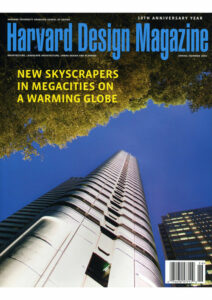Innovate or Perish: New Technologies and Architecture’s Future
Innovation is a development that people find useful or meaningful. To be innovative, architects—and works of architecture themselves—must become more responsive to their users and environments. In other words, they must incorporate feedback from their physical and cultural contexts rather than relying solely on conventional analytical or internal processes of development . . . from design to construction.
— Ali Rahim, architect1
While a few “starchitects” are being showered with praise, the forecast for many in the profession is partly to mostly cloudy. In 2005 only 2% of architects in Britain were “very happy” with their jobs—scoring at the bottom of thirty professions surveyed, and below civil servants.2 These sentiments are hardly limited to Britain, as Dana Cuff illustrates in her Architecture: The Story of Practice. Many among the general ranks of architecture are dismayed by the elusiveness of success and by their diminishing impact.3
There are two primary reasons for these phenomena—one cultural, the other methodological. Architects are among the very few providing custom design services in a product-infatuated society. This presents a profound problem, especially since few clients possess an understanding of the efforts necessary to create custom products, and even fewer are willing to adequately finance them. Second, while emerging digital technologies offer architects radically new possibilities for designing and building, current architectural speculation remains largely confined to timid evolutionary steps. Many in the profession are finding it difficult to leave behind the security blanket of past working traditions, while a few are simply choosing to pull it resolutely over their heads.
Architects’ refusal to embrace technological innovations invites their extinction. Less hidebound professions are ruthlessly shoving their way onto the turf once the sole domain of architects. The capabilities now provided by furniture system designers, sustainability consultants, construction managers, and engineers of all stripes have become so advanced that Martin Simpson of Arup Associates suggests that architects may eventually become unnecessary—except, perhaps, as exterior stylists.4 To avoid obsolescence, architects need to increase demand for their skills by embracing emerging technologies that both stimulate and satiate consumer desires. For savvy architects with a dash of fortitude, revolutionary opportunities for creating enhanced predictability, complexity, branding, feedback, and economies of scale glimmer on the horizon.
In this essay I will focus on the potentials of new design and building technologies, centering my comments on improving architecture’s marketplace success. I invite speculation about the profound impact these technologies will have on designers’ aesthetic, political, and social powers, which I will not address here.
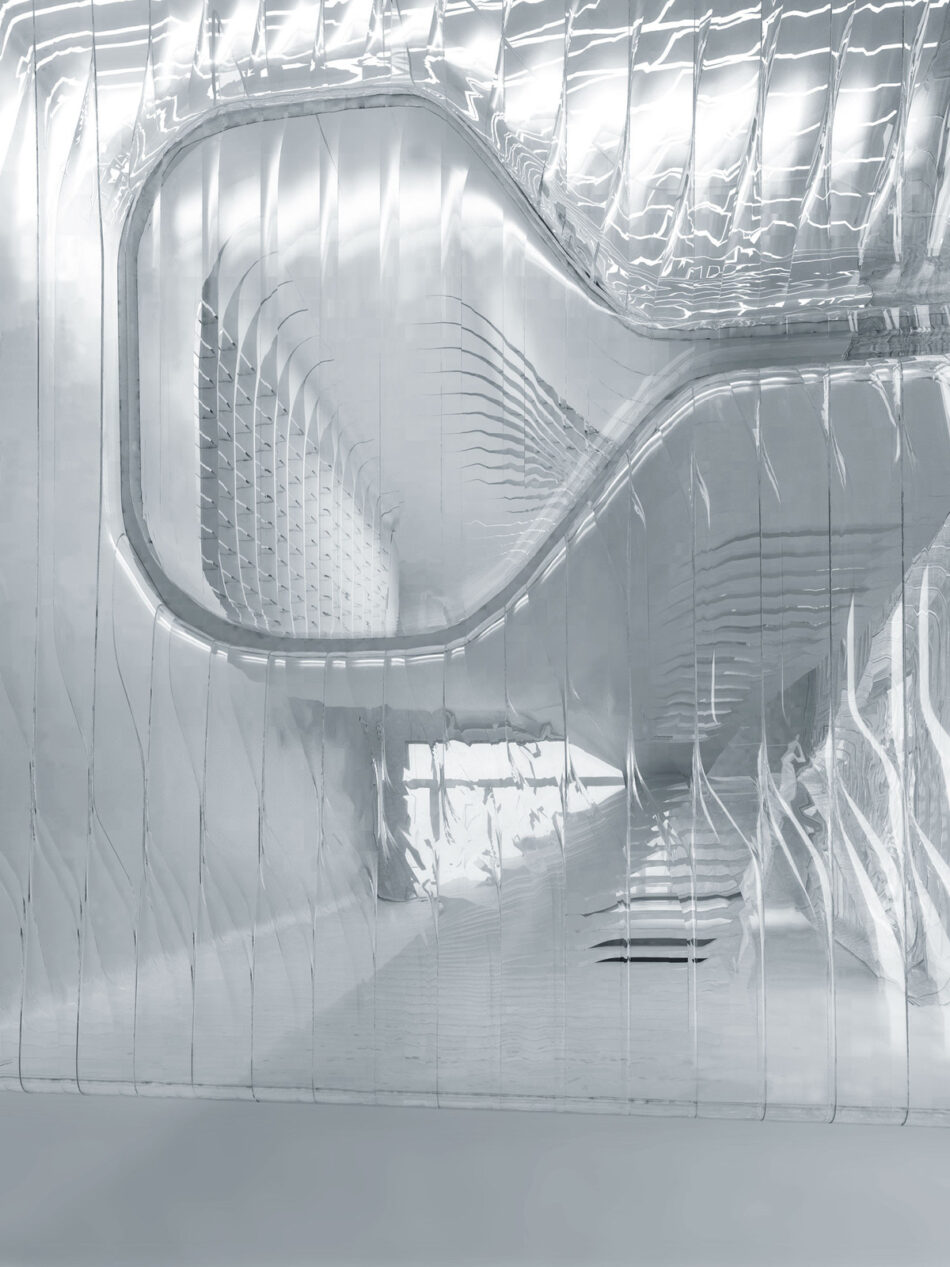
The Case for Revolution
The New Yorker’s architecture critic Paul Goldberger is among those encouraging technological and business revolution, suggesting that, due to a rise in visual literacy and an insatiable quest for status among consumers, the time is ripe for architects to better harvest consumer desires. At the Fixed Income Forum in 2004 he noted, “I have to admit that the guy who drives a BMW or an Audi (whose parents drove an Oldsmobile) is not doing that only because he knows the Audi looks better — he is also doing it because of the status that ascribes to that name, and now, that status is available to (and sought by) a far broader segment of the population than it once was.”5 Why don’t people lust after fine buildings to the extent that they do BMWs and Audis? The answer is simple—they can’t. Architecture is sold in units of one.
Architect-writers Dan Willis6 and Kieran Timberlake7 point toward technologies like BIM (building information modeling), mass customization, parametric design, and prefabrication as ways to pull architects out of their deepening ditch. To this list we should add rapid prototyping, digital fabrication, ubiquitous computing, and online web ordering that permits product customization. What follows is a kind of Rough Guide for the Intrepid Architect—an insider’s look at emerging technologies harboring both speculative possibilities and potential rocky shoals.
Tailor-Made: Lessons from the Past
The question of whether to continue making “one-off” products or to make multiple variations of a product is one architects need to address. The saturation of manufactured goods today has had a profound impact not only on consumers, but also on providers of custom-made goods. Consider the once flourishing tailoring trade, which, as a consequence of mass production, has shrunk to one sixteenth its size from 1920 to 1990.8 Today, industrialized societies have gleefully traded fit, finish, and durability in exchange for savings, variation, brand-name identity, transient fashions, and immediate gratification. To imagine that this trend has little meaning for architects today would be foolhardy: “Architecture, as an industry, broadly conceived, has become less and less able to deliver a superior evolving and popularly engaging product that can compete with other more successful products. . . . And the less successfully architecture has competed with these diverse ‘growth industries,’ the less architects have been entrusted with time and money to perform work on a scale and with a quality that could perhaps turn things around,” wrote Michael Benedikt in these pages.9
Today’s consumers fundamentally lack an understanding of the complexity of creating anything tailor-made, let alone a substantive (and emotionally complex) object like a new building. Architectural clients soon find themselves lost amid a bewildering world of possibilities and complications that they are unprepared for because of their customary reliance on mass-produced goods. Rather than being exhilarated by the process, they are often left with remorse, since they must eliminate countless desirable options along the way.10 While a few may enjoy the ambiguity, attention, cost, and complexity of the architectural process, many conditioned by the modern conveniences of ready-made products, web ordering, and overnight delivery are simply frustrated by it.
Rapid Prototyping Evolves to Rapid Fabrication
Would that client-related problems were architects’ sole challenge. Because few innovations are specifically geared toward the construction industry, Toshiko Mori urges architects toward a practice model invigorated by “creative appropriation of advances made in non-architectural areas.”11 One such advance unnoticed by most architects (but celebrated by industrial designers, engineers, and manufacturers) is rapid prototyping technology—exciting for what it already is but deliriously enabling for where it will go.
First introduced in 1986 by 3D Systems as stereolithography (SLA), this three-dimensional printer uses laser curing of resin, built one layer at a time, to create scale models.12 SLA still thrives and has been joined by a number of other rapid prototyping devices that now include printing in plaster, plastics, rubber, resins, and even powdered metal that can be fused into durable parts by companies like Extrude Hone.13 Once confined to volumes of less than 1,000 cubic inches, these machines have grown within twenty years into wizards capable of printing full-size human figures.14 Rapid prototyping—with weak modeling materials is evolving into rapid fabrication of high-quality components used directly in medical implants, machinery parts, and aerospace applications. The rapid prototyping industry is burgeoning, with both scale and quality predicted to increase, while price declines.15 In fact, the 3D printing craze is just beginning, with Professor Hod Lipson of Cornell University recently launching an open-source project at fabathome.org with instructions on how to build your own 3D printer for $2,400, which can print in a variety of materials, including chocolate.16
As this trend continues, 3D “printing” of full-scale building structures seems inevitable—especially considering that graduating digital designers are now creating 3D models by printing them and are eager to realize large-scale fabrication of complex forms that can’t readily be built by hand. Large 3D-printed structures (up to 14′ x 20′ x 8′) can already be made in concrete using a prototype unit developed by University of Southern California industrial engineer Behrokh Khoshnevis. Khoshnevis can see no reason why rapid prototyping technology won’t eventually be scaled up, especially as material costs come down and funding increases.17 Architects using rapid fabrication technology at a building scale could economically create complex singular designs as well as customizable multiples. First these will appear as building components and later as full-scale structures.
In 1957, an MIT collective envisioned the plastic Monsanto House of the Future for Disneyland.18 If fifty years later Houses of the Future were envisioned as daringly, they would surely be the offspring of a union between digital design and automated rapid fabrication. Not limited to simplistic adobe-esque load-bearing styles, these homes would come in a variety of forms ranging from traditional to avant-garde and would be available in many durable colors, textures, materials, and translucencies. Complete with injury-free, pliable children’s rooms, these structures (likely constructed with five-axis extrusion heads and sonic welding already used for utility piping) will be capable of complex shapes that would make even Gaudí envious. A significant side effect will be that ornament will again proliferate, since complexity will no longer have a direct relationship to labor cost.
Such structures would replace traditional stick-framing and allow a variety of traditional forms and materials to continue, but could also be fully exploited by Modernists interested in displaying the intrinsic nature of these monolithic materials. Structures printed in multiple materials could integrate expensive nuisance items like mechanical chases, extruded plumbing channels, and conduits complete with electricity-conductive slurries. Integrating features like showers, sinks, shelving, cabinets, furniture, and far more would eliminate much of the current time-consuming coordination between various trades. Electrical power could be fashioned like circuit boards with plug-and-play wiring harnesses like in computers or cars, serving as a nerve-like web running just below the building’s skin, eliminating traditional outlets and permitting power almost anywhere.
Environmentalists will rejoice over printed buildings, since 92% of building waste is now the result of renovation and demolition.19 Dramatic reductions would be possible because “printed” structures would be almost entirely recyclable, since the diverse materials used would easily be disassembled and auto-sorted much the way trash is today. Additionally, designers will be able to easily perform analysis of finite structural elements, enabling a whole new level of structural comprehension and daring, and wresting a good deal of power from structural engineers. Best of all for consumers, the duration, amount of material, and cost of a project will be fairly precisely known in advance. Of course, the inevitable curve ball hurled at architects is if (read: when) people themselves design and build their “dream houses” using programs like Google’s free 3D modeler SketchUp in conjunction with intrepid 3D-printing contractors, thus ensuring lively design review hearings for some time to come.

Parametric Design
Because parametric design is ideally suited to the mastery of rapid fabrication, John Nastasi of the Architectural Product Lab at Steven’s Institute believes that parametric design skills need to be among the dozen or so capabilities that define the digital toolboxes of forward-looking architects.20
Parametric design allows users to modify relationships between various features while tracking the history of those changes, thus updating all interrelationships performed after the modification. A very simple example of this might be a hole in a wall that will always be automatically placed at one half the height of the wall, regardless of the wall’s size.21 This is a common technique used in product fabrication, but the precision involved in manufacturing software (accurate to thousandths of an inch) can be limiting to free architectural design exploration.
Thus several architects like Greg Lynn, Office DA, and Penn’s Graduate Design Research Studio’s director Ali Rahim have instead adopted the animation program Maya because it permits more fluid design exploration with less emphasis on manufacturing tolerances. Maya has several beneficial attributes that aid in conceptual design studies: Manipulation of mathematical algorithms using Embedded Language scripting can autogenerate forms as complex as skyscrapers (commonly done by students of Kostas Terzidis at the GSD),22 ease rapid prototyping of study models, and create compelling and informative walk-through animations. The number of potential parametric relationships is limited only by the diversity of data and the imagination of the designer. The benefit for architects is that a fully developed singular parametric design project may be easily tweaked to create wildly dissimilar results for other projects. Complex results dazzle the uninitiated, but can be surprisingly simple to generate for those with an understanding of how parametric design works.
BIM
Parametric design goes well beyond mere formal pyrotechnics. Inherent to Building Information Management (BIM) is parametric design software tied to data contained in spreadsheets. Changes made to either the digital model or the database automatically update and coordinate throughout the model and spreadsheet.23 Due to the extent of the previsualization it allows prior to construction, BIM diminishes ambiguity, reduces errors, and generates savings for clients.24 The AIA, through its Technology and Architectural Practice committee, even has a new special awards program for BIM projects.25 In theory, since architects deal with ever-changing information, BIM sounds almost too good to be true. In practice, benefits will not be realized without some possibly serious drawbacks that I will soon discuss.
Vladimir Bazjanac, at the Lawrence Berkeley National Laboratory, marvels at the uniqueness of the current architectural process, commenting that architecture, without sophisticated previsualization provided by BIM, is little more than a “convince-build-pray modus operandi.”26 Bazjanac sees BIM as a way for architects to emulate manufacturers’ efforts to imbue project delivery with greater certainty. He is partially right, but what he is perhaps missing is that, in the world of products, complete documentation of minutiae makes economic sense only because design is a very small fraction of the total cost of products. This is not the case with architecture.
Chris Kasabach, director of product marketing for BodyMedia (Cooper Hewitt’s biomedical darling),27 indicates that because of digital design models, industrial designers are changing their processes and teaming up with fabricators early in the design phase. The result is that during the prototyping phase an increasing amount of digital redesign is being done remotely by fabricators. When asked who pays for this redesign, Kasabach enthusiastically responds, “The prototyping companies do. Essentially, they consider ‘design’ an insignificant and necessary cost of manufacturing.”28
Despite the disparity between products and architecture, the General Services Administration (GSA) has required architects to perform full BIM modeling on selected projects since 2003 and is now requiring partial BIM models on all federally funded projects, and is considering full BIM for all future projects.29 Their experience is a reduction in change orders saving the GSA up to 10% of total construction costs.30
Clearly clients are benefiting, but what about architects? When I questioned Luciana Burdi, head of Capital Asset Management for the State of Massachusetts, on the lack of increased architectural fees for BIM projects, she replied, “Architects are paid to provide buildings without errors, why should they be paid more to do this?” For clients, BIM infatuation is easy to understand—they want savings, and the rigorous BIM process complies. Unfortunately, this magic elixir has one possibly terminal side effect for architects—clients are developing an insatiable expectation for perfection from uniquely made buildings. While BIM possesses fairly powerful tools for error reduction, it is simply incapable of error elimination. Burdi went on to express frustration over an expensive error in a recent BIM project—one that she felt should have been caught by the architect prior to construction—thus underscoring that for architects there is a distinct danger that BIM will result in a triple-whammy: more work, less profit, and increased liability.
Despite these challenges, 34% of architects are using some form of BIM modeling. But for most this is only during conceptual stages to generate rudimentary cost data and quantity takeoffs helpful in evaluating the expense impacts of various schematic designs—not for full BIM production.31 Profitable implementation of full BIM seems to require at least one of two components. The first is for architects to retain ownership of BIM data so that they may use that data in future projects of similar typologies to amortize the first use-costs of development. However, the GSA prohibits this and wants sole ownership of the data. The second, using the industrial design model, is for architects to bring fabricators with BIM skills into the design process early for assistance in the development of the digital BIM model. This, too, is prohibited by the GSA since they require traditional design-bid-build process.
Ostensibly the group with the most lobbying power for beneficial BIM conditions for architects is the AIA TAP committee. Stephen Hagan, Director of the GSA’s Project Knowledge Center, has served on this committee for the past four years and was Chair last year.32 When I asked Douglas Paul, AIA Director of Professional Practice, whether this relationship might not be an overly cozy one for the GSA at the possible expense of architects’ well-being, Paul indicated that this concern had never been raised before.33 Hagan seems a good fellow and has earned FAIA wings, but if I’m the first to question—make that be astounded by—this relationship, one can only wonder who is spiking the AIA’s water cooler.
The power of BIM is well documented, and its software will continue to improve. However, full BIM modeling for singular enterprises is ultimately not beneficial for architects, since the time (and thus, cost) of such a complex endeavor is much higher than normal one-off design services. Development of a full BIM model is almost as complex as physically making the actual object and one that makes economic sense only in a mass-production / customization context. Alternatively, one could also be paid very handsomely for singular full BIM modeling—but this seems unlikely.
An imperfect but illustrative parallel in manufacturing would be if Boeing were contacted to digitally design and construct a one-of-a-kind “blue-sky” airplane. The client is interested in exclusive rights to Boeing’s five years worth of design data,34 prohibits Boeing from making more than one plane, will only pay for error-free parts, and expects to pay little (or no) more than the cost of a standard plane of similar size. Boeing wouldn’t even bother to return the call, yet architects are competing for design opportunities where the conditions aren’t that much different.
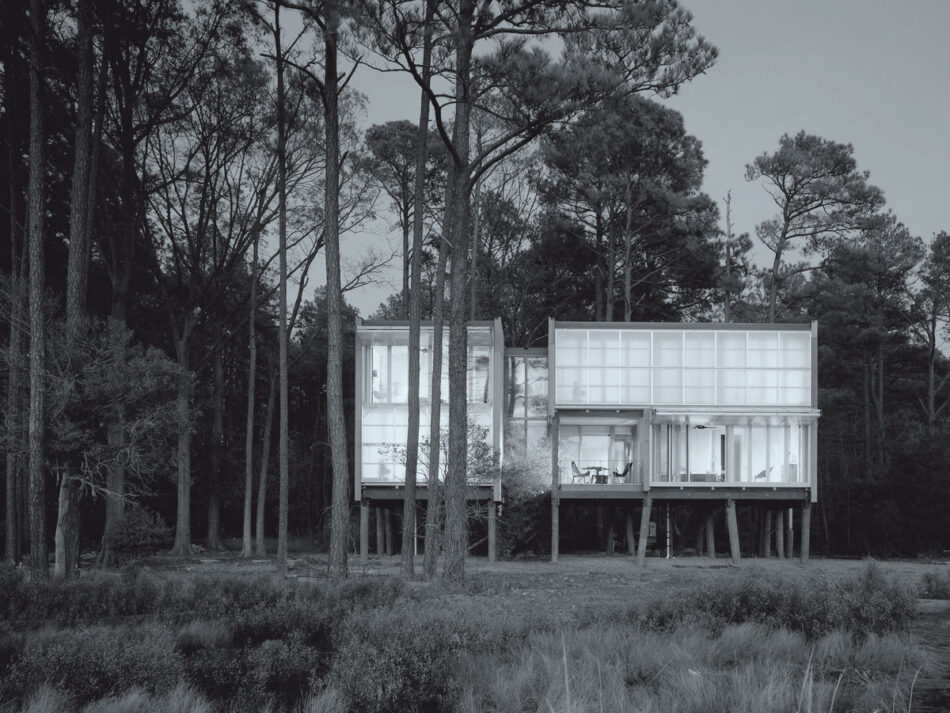
The Digital Master Builder
Once, as “master builders,” architects both designed and built structures. However, architects relinquished their direct role in the building process centuries ago and have instead relied on 2D drawings to describe their visions to specialized builders. Today this communication process is rapidly changing as a direct result of digital fabrication introduced in 1971 by technology developed at the French automotive company, Renault.36 Drawings are being augmented—if not entirely replaced—by processes that permit 3D fabrication of complex forms directly from architects’ data. In this context, the much-vaunted 1997 Guggenheim Bilbao, celebrated for its convoluted artful forms, is far more groundbreaking for its use of innovative digital construction processes in which Gehry’s office assumed responsibility for the accuracy of fabrication.37
Although this is not in itself news, direct digital communication has reinvigorated the concept of master builder for a few architects. Repopularized some thirty years ago by the radical Jersey Devil architectural group, the design-build method means the responsibility for design and production are provided by the same party. Pedagogically significant since it opens up a fertile dialectic between design and tectonics, there is again tremendous interest in this model in academia—most notably in the revered Rural Studio, initiated in 1993 at Auburn University by the late Samuel Mockbee. Many other schools have adopted design-build in their curriculum, often relying on digital fabrication for components in such things as Solar Decathlon projects,38 material research, formal investigations, and community-based initiatives. The upshot of this is that more emerging practitioners are once again enthusiastic about possibilities inherent in varying levels of participation in the actual making of design.
Design-build today has two distinctly different branches—the decidedly larger one (dominated by contractors) deals primarily with profit optimization, while the smaller (but more interesting tectonically) deals with product optimization. A few architectural firms have thrown themselves into the opportunities presented by this latter area by exploring the union of 3D design with 3D fabrication, creating works that range from sculptural objects and surfaces to full-sized buildings. These provocative offerings (often exploiting the possibilities of parametric design) are from the likes of Bill Massie, Thom Faulders, Forsythe + MacAllen, Evan Douglis, SHoP, John Nastasi, Byoung-Soo Cho, and many others.39 The attention that these efforts are receiving suggests that design-build innovation can readily yield increased stature for talented newcomers.
Further reason that architects should pay more attention to this area is that at the current rate of change in the building industry, design-build project delivery is expected to surpass traditional design-bid-build methods by 2010.40 For architects with the courage to branch out from their well-entrenched methodologies, tremendous opportunities for increased complexity, control, and economies of scale through digital fabrication lie ahead. Such endeavors permit industrious architects to focus design efforts and material explorations on specific areas of architectural significance (regardless of scale) and thus reassert themselves as master builders.
Prefabrication
As was outlined in a report by the British Department of Trade and Industry, the advantages of building houses in factories abound—reductions in time for site work, weather disruptions, coordination of workers, delivery, labor shortages, waste, damage in shipping, and water and energy use, plus increases in recycling, precision, and quality control. Collectively these benefits generate a dramatic reduction in total embodied energy and environmental impact of structures, despite the cost of shipping the finished product.41
Prefabricated housing (including “mobile homes”) is a $54 billion industry in which the United States provides 80% of the stock globally. The U.S. leads sales, with 6.4% of its population living in prefabricated units,42 followed by Japan, and with Latin America the fastest growing market.43 Ninety-seven percent of manufactured homes move only once from factory to site.44 While possibly energy efficient and well made, prefabricated homes have struggled to gain cultural acceptance in the U.S. due to the lingering dread associated with sagging mobile homes propped up on blocks with wheels dangling like vestigial organs—an unexpected result of tax and zoning laws. Convincing antidotes for this unsavory image have been presented in delightful neo-Modernist efforts presented by Dwell magazine and by over thirty designers at www.fabprefab.com—many of whom address possibilities of prefabrication decoupled from a static foundation.
Why has prefabrication failed to catch on? My sense is that several components are missing from current efforts, and a few large hurdles remain to be cleared. The obstacles come in the form of close-minded community groups, outdated zoning codes, cainophobic design review boards, and restrictive covenants. These fears stem from a stigmatization of the typology that arose as a result of the post-WW II housing boom when prefabrication (think Levittown) meant “cheap” in both economic and cultural senses. By contrast, Sears’s homes prior to WW II were neither, selling over 100,000 from 1908 through 1940,45 many of which bear historic plaques today. Within Sears’s treasured antique catalogs are salient clues for future efforts—the creation and wide promotion of desire, industrial commitment large enough so that results are not simply regional, and tight integration of diverse systems. Kieran Timberlake have soundly scored on many of these counts with their recent Loblolly house built by LivingHomes, an environmentally focused prefabricator. Steven Glenn, founder of Living Homes notes, “If our major focus is making the product better, quicker, cheaper, and with a smaller ecological footprint, we need a high level of technology integration.”46
What follows is a paradigm-shifting vision for dwellings. For the adventurous, the recreational vehicle (RV) offers an often overlooked alternative form of prefabrication. Travel trailers (RVs without engines) were once so popular that in 1935, the predictor of the stock market crash, Roger Babson, hazarded another shocker, “Within twenty years, more than half of the population of the United States will be living in automobile trailers.”47 Indeed, prior to World War II, there were over 400 manufacturers of travel trailers,48 yet Babson’s power of prognostication failed to identify the war that quickly gutted the industry. Today, with Baby Boomers eagerly embracing alternative retirement lifestyles, tremendous growth is once again occurring in the market for mobile dwellings. A University of Michigan study indicates that one in twelve vehicle owners currently possesses an RV, and one in six surveyed intends to buy an RV within five years.49 For increasing numbers, RVs have become a desirable form of temporary or permanent living reinvigorated by wireless voice and data technology, easy financing (complete with second-home tax benefits), significant configurability, integration of premium technologies for home theater, advanced energy management, integration of green elements like biodiesel fuel and solar electricity generation, and, perhaps most appealing, “drop-of-the-hat” mobility surrounded by one’s “stuff.”
The design of mobile dwellings represents a significant opportunity not being taken by architects, with the exception of Christopher Deam in his work for Breckenridge50 and Airstream.51 Architects could and should be pushing the boundary of RVs in the form of technologically enabled customizable structures with interchangeable components that would permit a variety of shipping techniques over land and sea. And with some ingenuity, the results need not look anything like the lumbering behemoths squatting near highway exit ramps.
Mobile dwellings have something else going for them. With enough shipping containers now in existence to wrap around the equator—stacked two high—inventive dwellings made from these modules makes some sense from a purely economic point of view.52 Work by Wes Jones of Jones Partners, Los Angeles; Jennifer Siegal of Office for Mobile Designs, Los Angeles; Hybrid Design of San Francisco; LOT-EK of New York City; Quick House designer Adam Kalkin of Bernardsville, New Jersey; and others has inventively explored the prefabricated shipping container as a base module for homes. While these projects may have the ripped-designer-jeans crowd worked up into a lather, their raw industrial quality will ultimately hinder wide public acceptance. However, they do offer an estimable lesson to carry forward: a standardized chassis using existing globally integrated transportation techniques. Mobile products based on such a chassis would allow multiple designers to create products that could easily work together to permit mass customization in a way portentously touted twelve years ago by Joseph Pine, author of the groundbreaking book Mass Customization.53 Like the prefabricated living suites by Piikio Works for the cruise ship industry,54 these creations need not look at all like shipping containers.
Storing increasing numbers of RVs is not a trivial problem. Rather than being parked in rural driveways or at sprawling storage facilities and camp sites (as is done with most RVs today), these dwellings could be lived in daily and driven, towed, lifted, stacked, and slotted into a variety of attractive rural, suburban, or urban structures and thus partially supplant vacation cottages, rental apartments, condos, and college dorms. They could be cleverly integrated into well-disguised slots in homes and high rises, or displayed in full “messy vitality” depending upon their context.
Today, with almost one third of the U.S. population renting their dwellings,55 architects pursuing this new typology might increase homeownership for low-income people. Imagine giving your newborns their own chassis at birth—their first home, something they could take with them when they leave the nest, replacing at least a decade of apartment rentals with minimal “docking fees” as they educate themselves, move about, and develop their careers.
This concept (which I call a Jump Box) offers technologically sophisticated, compact, and amenity-rich living. Well-branded models will be featured in magazines and become as desirable as cars—with one big difference: A durable chassis would permit every aspect to be easily upgraded over time as fashions, finances, and technology evolve. With one in six U.S. dwellers moving every year,56 relocaters would be liberated from the complex and expensive affair involved in renting (or buying) a new abode, then frantically packing and unpacking for the next several months—a process equal in stress to the loss of a loved one or divorce.57
Instead, a spicy little structure could be ready to ship to a new location in an hour or less, consuming a fraction of the energy required to move into (and live out of) a bloated McMansion. Architects should be pioneering the design of these enabling, product-like dwellings along with an expansive range of ever-evolving components. Architects could also provide the vision necessary for a whole new typology of dynamic “docking” structures beneficially integrated into the urban context. We now see an explosive growth of rural-bound RVs, partially since cities are simply incapable of accommodating them. Cities that embraced mobile structures would certainly benefit on many levels from an influx of the highly desirable, increasingly mobile “creative class,”58 while reducing commuter congestion and increasing tax revenue.
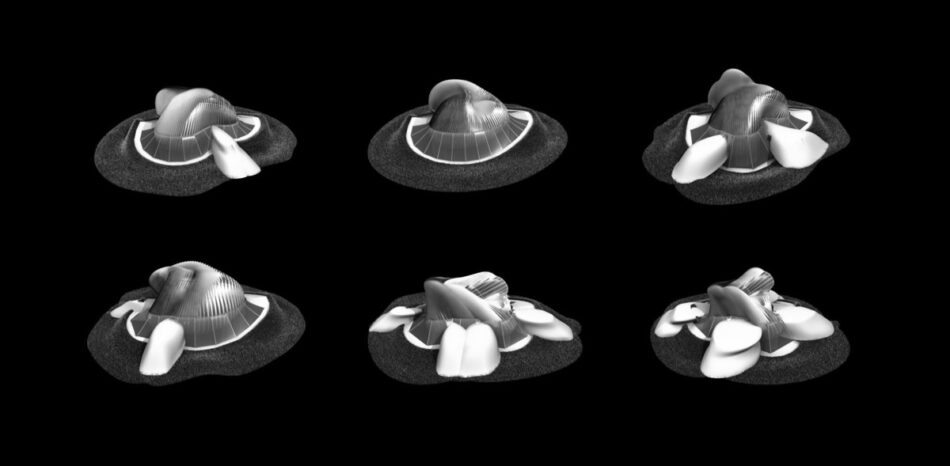
Ubiquitous Computing
Mark Weiser, the recognized father of embedded technology, has written, “The most profound technologies are those that disappear. They weave themselves into the fabric of everyday life until they are indistinguishable from it.”59 Accordingly, intelligent architectures, with the ability to recognize and incorporate sophisticated sensors already inherent in cell phones, clothing, and other products would permit powerful feedback loops about their users, thus improving the design and usefulness of environments.
With origins in 1946 Soviet spy devices,60 various forms of ubiquitous computing—embedding computation into the environment and everyday objects—today appear in such amenities as EZPass, cardswipe doors, automated parking systems, and tracking of library books. Radio Frequency Identification (RFID) tags (small radio receiving chips) enable this technology.
In accordance with the idea outlined a decade ago by Christian W. Thomsen in Visionary Architecture,61 a short list for architects of the possibilities enabled by RFID technology includes such things as signage displayed legibly in one’s own language, doors unlocking as one simply walks up to them, lighting and sound adjusting to suit one’s preferences or mood, blinds cooperating with heating and cooling cycles, auto-sorting of waste, rooms that could auto-adjust to optimize performance based on the number of occupants, and coffee makers that would leap into action when you wake up.
Branding Desire
These emerging technologies with implications for architecture include some necessary ingredients—but require a generous dollop of desire. According to a recent article by business professor Banwari Mittal, our culture relies heavily upon brand-name products for self-identity,62 and membership in today’s consumer collective is gained through the purchase of celebrated popular products rather than unique hand-knitted sweaters from Grandma. Oxymoronically, people assert their “individuality” through their display of mass brands and accessories. Accordingly, one begins to understand the challenges for Modernist architecture as outlined in Anthony Alofsin’s The Struggle for Modernism63—deviation from commonly accepted architectural practices is for visionaries, heretics, and hippies, not ordinary consumers.
As Michael Sorkin suggested in his pungent Harvard Design Magazine article “Brand Aid,” “to create the success of any commercial multiple, the brand is critical. . . . And, of course, celebrity is the main measure of authority in Brandworld.”64 With several starchitects already on the lips of today’s consumers (Rem Koolhaas, Frank Gehry, Zaha Hadid, Michael Graves, Philippe Starck, . . .) fame may be enough to generate desire—but only if your name is already a brand. Peggy Deamer weighs in on the topic of fame versus brand: “[Architecture] does not conform easily to what we have said characterizes fame (inaccessibility and the clear identification of author with product). Likewise, its size, expense, and long production time make each object unique and singular, precluding it from notions of branding (repeatability and accessibility). It is perhaps for this reason that fame and branding are both elusive in architecture.”65 Yet Deamer seems to waffle about the importance of brand, squeezing off a potshot at brand-makers, “Fame is still linked to creativity, while branding is linked only to calculation.”66 Mass-produced products gain popularity and fame for reasons that go well beyond simple branding, including ostensibly stolid ones: reputation, value, desire, durability, and performance. Branding is not the destination but simply the vehicle that propels products into the limelight. To wit, and perhaps contrary to Deamer’s assertion, OXO Good Grips have not garnered over ninety awards simply because their name is a calculated palindrome.67
True, brand manufacturers enjoy the ability to chart quantitatively the sizzle in their steak through market share statistics. Conversely, architects seem to rely more upon an ethereal drool index based on abstract qualitative data like published work, who is invited to serve on what jury, the number and type of awards received, and intangible associations with glitterati including the usual heavy-hitting patrons, critics, notables, and fat cats. Do these divergent methods suggest a lack of creativity for manufacturers or a lack of reality for architects?
Architects who seek wider success may need to brand their work in recognizable ways. Instead of trying to launch a brand from a position of obscurity, architects might associate with recognized brand names as Michael Graves did in partnering with Lindal Cedar Homes and Target to offer customizable pavilion structures through Target’s website.68 The one formidable aspect, as in dating, is that such partnering requires give as well as take.
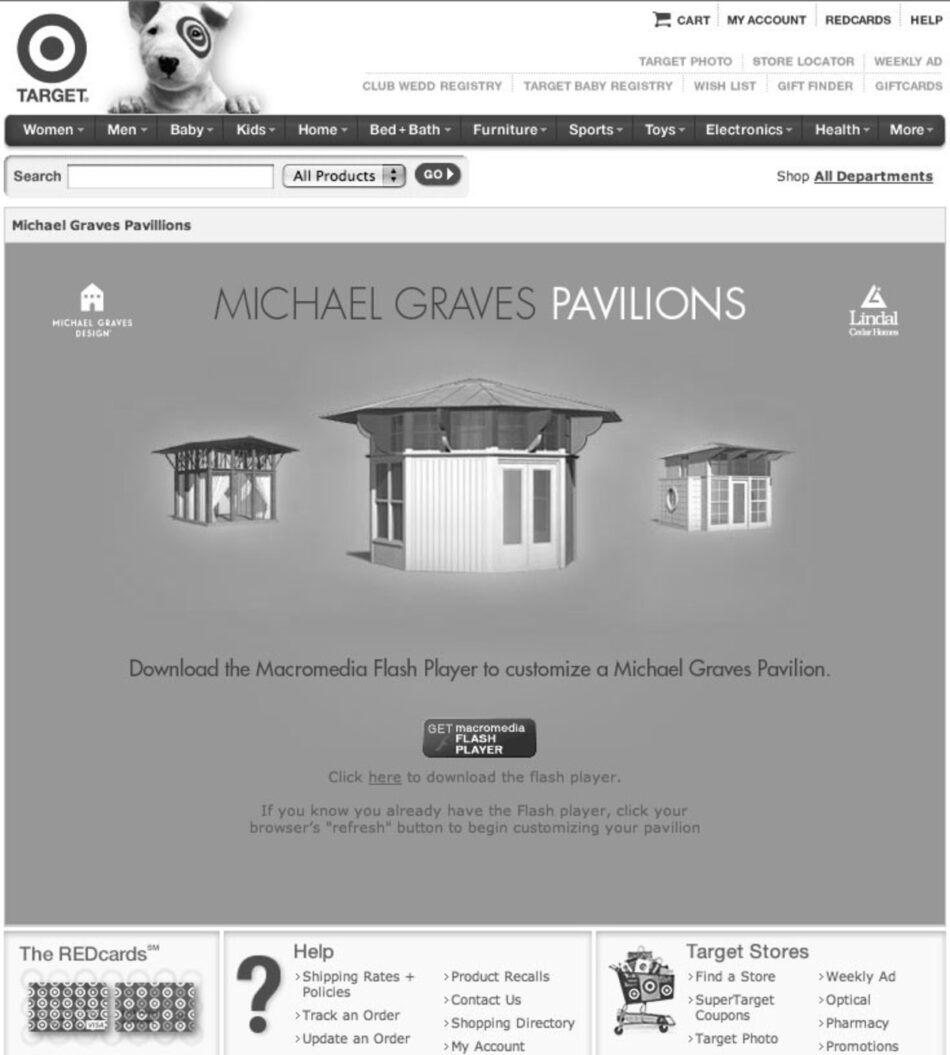
Accessorizing Desire
Architects now operate under the false premise that people want to be involved in the creation of their buildings. This supercilious belief flatters architects’ need to be needed, but is simply not borne out in practice. People love to accessorize, and nothing does this better than the World Wide Web. Online ordering represents a powerful opportunity for architects because of its multilayered ability to tender interaction, option visualization, pricing variations, data linking, and statistical analysis of items that generate consumer interest—thus providing a beneficial feedback loop for product development—as is now being done by Bensonwood Homes with their online building configurator.69 Of further attraction to architects is that virtual 3D models are often all that needs to be displayed, and the virtual revels in this task.
A stunning example of a saturated online experience worth emulating may be found at www.miniusa.com, where we can fantasize about our new individualized Mini Cooper that (BMW swears) can be built in over ten million configurations. These include tasty options like sports suspension, Bang and Olufsen stereo, and of course, racing stripes—complete with a running total of the price and the ability to save your order for future fidgets. Architects harnessing this process could interact with consumers to customize their fantasies in a way that both find rewarding. A provocative conceptual poke in this direction may be seen in the Resi-Rise Skyscraper by KOL/MAC, exhibited at the 2004 Venice Biennale International Exhibition, complete with a configurable online ordering system.70
A Peek at the Future
John Habraken, theoretician and former head of architecture at MIT, suggested at the 2007 conference Global Place: Practice, Politics, and the Polis71 that “Modernism was in essence an age of transition. Architecture needs to be well informed and restless, offering advanced personal environments.” Even the venerable Frei Otto expresses concern for the current architectural climate, writing, “Today’s architecture is at a turning point. The big trends of the last decade are outlived and only a few buildings in the world manifest architectural perfection while paving new ways into the future.”72 These warnings, considered in light of the dramatic and unprecedented changes which our society is rapidly undergoing, suggests we are reaching a tipping point toward new architectures.
Architects are teetering on this tipping point. The current architectural model is unduly weighed down by centuries of outdated working methodologies and singular prototype creation. Three primary limitations must be quickly dealt with. First, the absence of substantive feedback loops (loops evident in product-design but absent in architecture) prohibits in-depth analysis, adaptation, and evolution of our work. Second, a lack of economies of scale because of one-off production prohibits architects from fully integrating new technologies. Third, consumers’ desire for an architecture that evokes status and collective identity is not well-served by the one-off, brand-free model of most architecture.
Despite architects’ fear of global homogeneity, people’s expectations for all products (yes, including architecture) have been dramatically reshaped in the last decade by increasingly positive experiences with Web ordering processes that suit their needs and lifestyles. As a result, a desire is growing among consumers for architectural alternatives that go well beyond architecturally erotic, post-rationalized digital forms, moving architecture into a realm that Ali Rahim suggests is “useful, meaningful, and sustaining.”73
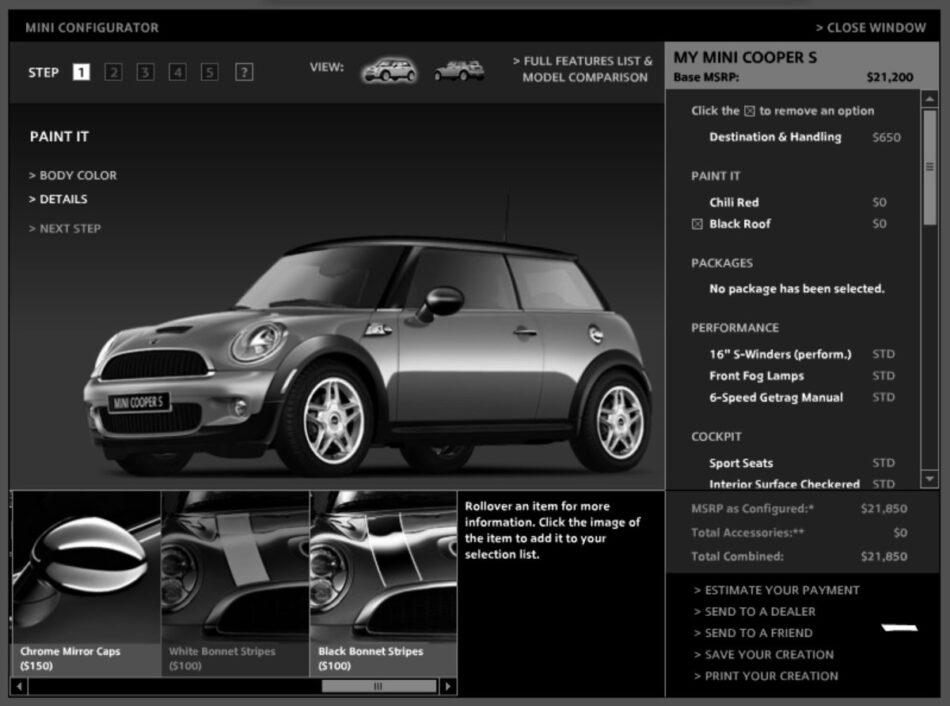
To increase its desirability and market share, architectures need to harness emerging technologies and tap more deeply into consumer desires, using both plurality and branding in product delivery methods. These efforts would be self-correcting—they provide an opportunity for architects to evaluate the success of their offspring quantitatively. Doing so would also encourage architects to move beyond “isms” geared toward revolutionizing aesthetic and social agendas every decade or so—a phenomenon that architects themselves can’t even keep up with—let alone the public at large, since architectural journals which feature these sorts of rapid-fire volleys (including this one) are rarely found nestled between The Economist and Vanity Fair at newsstands. Two decades of fanciful catalogs stuffed in mailboxes have done more to shape popular taste (and educate people about design) than the club of architectural priests that has elevated its game by preaching to the converted while leaving out the laypeople that architects ultimately need.
There are manifold implications inherent in these musings that are beyond the scope of this essay; I will leave the morality plays for others. What appears certain is that enhanced business success for architects will depend on weaving the technologies explored here into the making of more desirable and functional environments for an evolving populace experiencing tremendous technological, cultural, and environmental change. Who is better suited for this task than those who envision futures and coordinate innumerable specialists already? For architects, embracing these possibilities is on the one hand frighteningly simple and on the other hand scandalously improbable, for it involves nothing more than the abandonment of thousands of years of precedent.
Lacking at the start of the twentieth century was the information needed to effect real change in the way we build. Tools to represent and transfer information instantly and completely are with us today. They allow connections among research, design, depiction, and making that have not existed since specialization began during the Renaissance.
— Kieran Timberlake35
